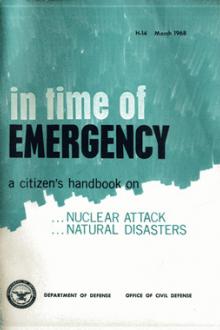author - "United States. Office of Civil Defense"

th blankets. She may have a slight chill. Give her a warm (not hot) drink of sweetened tea, milk, or boullion. Wipe her hands and face with a damp towel. She may drop off to sleep.
The mother's diet after delivery may include any available foods she wishes. She may eat or drink as soon as she wants to, and she should be encouraged to drink plenty of fluids, especially milk. Canned milk can be used and made more palatable by diluting with equal parts of water and adding sugar, eggs, chocolate, or other flavoring.
For the first 24 or 48 hours after delivery, the mother will continue to have some cramping pains in the lower abdomen which may cause a great deal of discomfort. Aspirin may help relieve these afterpains. She should empty her bladder every few hours for 2 days following the birth. If her bowels do not move within 3 days after delivery she should be given an enema.
MISCARRIAGE
If a pregnant woman shows evidence of bleeding, she should restrict her activities and rest i

nts, weather conditions and other factors. There isno way of predicting in advance what areas of the country would beaffected by fallout, or how soon the particles would fall back to earthat a particular location.
Some communities might get a heavy accumulation of fallout, whileothers--even in the same general area--might get little or none. No areain the U.S. could be sure of not getting fallout, and it is probablethat some fallout particles would be deposited on most of the country.
Areas close to a nuclear explosion might receive fallout within 15-30minutes. It might take 5-10 hours or more for the particles to driftdown on a community 100 or 200 miles away.
Generally, the first 24 hours after fallout began to settle would be themost dangerous period to a community's residents. The heavier particlesfalling during that time would still be highly radioactive and give offstrong rays. The lighter particles falling later would have lost much oftheir radiation high in the atmosphere

th blankets. She may have a slight chill. Give her a warm (not hot) drink of sweetened tea, milk, or boullion. Wipe her hands and face with a damp towel. She may drop off to sleep.
The mother's diet after delivery may include any available foods she wishes. She may eat or drink as soon as she wants to, and she should be encouraged to drink plenty of fluids, especially milk. Canned milk can be used and made more palatable by diluting with equal parts of water and adding sugar, eggs, chocolate, or other flavoring.
For the first 24 or 48 hours after delivery, the mother will continue to have some cramping pains in the lower abdomen which may cause a great deal of discomfort. Aspirin may help relieve these afterpains. She should empty her bladder every few hours for 2 days following the birth. If her bowels do not move within 3 days after delivery she should be given an enema.
MISCARRIAGE
If a pregnant woman shows evidence of bleeding, she should restrict her activities and rest i

nts, weather conditions and other factors. There isno way of predicting in advance what areas of the country would beaffected by fallout, or how soon the particles would fall back to earthat a particular location.
Some communities might get a heavy accumulation of fallout, whileothers--even in the same general area--might get little or none. No areain the U.S. could be sure of not getting fallout, and it is probablethat some fallout particles would be deposited on most of the country.
Areas close to a nuclear explosion might receive fallout within 15-30minutes. It might take 5-10 hours or more for the particles to driftdown on a community 100 or 200 miles away.
Generally, the first 24 hours after fallout began to settle would be themost dangerous period to a community's residents. The heavier particlesfalling during that time would still be highly radioactive and give offstrong rays. The lighter particles falling later would have lost much oftheir radiation high in the atmosphere